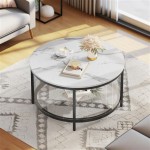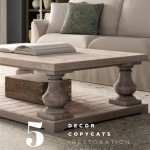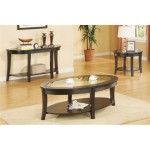Marble Coffee Table With Wood Legs: A Study in Material Contrast and Design Versatility
The marble coffee table with wood legs represents a harmonious fusion of natural materials, offering a piece of furniture that is both aesthetically pleasing and functionally sound. This combination showcases the inherent beauty of marble, a material celebrated for its unique veining and luxurious feel, juxtaposed with the warmth and organic texture of wood. The resulting design is adaptable to a variety of interior styles, from minimalist modern to rustic chic.
The increasing popularity of these tables stems from their ability to act as a focal point in a living room setting. The cool elegance of marble balances effectively with the sturdy groundedness of wood, creating a visual equilibrium that is both comforting and sophisticated. This article will explore the key characteristics, design considerations, and practical aspects of marble coffee tables with wood legs.
The Allure of Marble and the Stability of Wood
Marble, a metamorphic rock formed from limestone or dolomite, possesses a timeless appeal due to its intricate patterns and smooth, cool surface. The variations in color and veining within each slab of marble ensure that every table is unique, adding an element of exclusivity and character to the piece. Common types of marble used in coffee tables include Carrara, Calacatta, and Nero Marquina, each offering distinct visual characteristics.
Carrara marble, sourced from Italy, is known for its white or light gray background with subtle, feathery gray veining. It is a versatile choice that complements a wide range of interior color palettes. Calacatta marble, also from Italy, is characterized by its striking white background and bold, dramatic veining in shades of gold, gray, and brown. This type of marble is often considered a more luxurious option due to its rarity and visual impact. Nero Marquina marble, originating from Spain, is a black marble with distinct white veining. Its dramatic contrast makes it a bold and sophisticated choice for contemporary spaces.
The selection of wood for the legs is equally crucial in determining the overall aesthetic and structural integrity of the table. Hardwoods such as oak, maple, walnut, and ash are commonly used due to their durability and resistance to wear and tear. The type of wood also contributes significantly to the style of the table. Oak, with its distinctive grain patterns, lends itself well to rustic or farmhouse-inspired designs. Maple, with its smooth texture and light color, is often chosen for modern or Scandinavian interiors. Walnut, with its rich brown tones and elegant grain, adds a touch of sophistication and warmth. Ash, known for its strength and flexibility, can be easily stained or painted to match a variety of design schemes.
The combination of a marble top and wood legs offers a practical advantage in terms of stability and longevity. Marble, while visually appealing, can be a heavy material. The use of sturdy wood legs provides the necessary support to distribute the weight evenly, preventing the table from tipping or wobbling. The wood legs also contribute to the table's overall durability, ensuring that it can withstand daily use and last for many years.
Design Considerations and Style Integration
The design of a marble coffee table with wood legs involves careful consideration of several factors, including the shape and size of the marble top, the style and finish of the wood legs, and the overall proportions of the table. These elements must work together harmoniously to create a visually appealing and functional piece of furniture.
The shape of the marble top can range from classic rectangular or square designs to more modern round or oval shapes. Rectangular and square tables offer ample surface area for placing items such as books, magazines, and beverages. They are also well-suited for larger living rooms where they can serve as a central gathering point. Round or oval tables, on the other hand, create a softer and more inviting atmosphere. They are particularly well-suited for smaller spaces where they can help to create a sense of openness and flow.
The style and finish of the wood legs play a significant role in determining the overall aesthetic of the table. Tapered legs, for example, are a hallmark of mid-century modern design, while turned legs evoke a more traditional or vintage feel. Straight, minimalist legs are often used in contemporary designs to create a clean and uncluttered look. The finish of the wood can also be customized to match the surrounding decor. A natural wood finish highlights the beauty of the wood grain, while a stained or painted finish allows for greater design flexibility.
Integrating a marble coffee table with wood legs into an existing interior design scheme requires careful consideration of the surrounding colors, textures, and styles. These tables can be seamlessly incorporated into a variety of design styles, from minimalist modern to rustic chic. In a minimalist modern setting, a marble table with clean lines and simple wood legs can complement the sleek and uncluttered aesthetic. In a rustic chic setting, a marble table with distressed wood legs and a weathered finish can add a touch of warmth and character. In a traditional setting, a marble table with turned wood legs and a rich wood finish can create a sense of timeless elegance.
The color palette of the room should also be taken into account when selecting a marble coffee table. A white marble top with light wood legs can brighten up a dark room, while a black marble top with dark wood legs can add drama and sophistication. Consider the colors of the surrounding furniture and accessories to ensure that the table complements the overall design scheme.
Practical Aspects: Maintenance and Durability
While marble coffee tables with wood legs offer aesthetic appeal and design versatility, it's essential to consider the practical aspects of maintenance and durability to ensure their longevity. Both marble and wood require specific care to maintain their beauty and prevent damage.
Marble, being a porous material, is susceptible to staining from spills such as coffee, wine, and acidic liquids. To prevent staining, it is crucial to seal the marble top regularly with a high-quality sealant. Sealing creates a protective barrier that prevents liquids from penetrating the surface. It is recommended to re-seal the marble top every six to twelve months, depending on the frequency of use.
Cleaning marble requires gentle methods. Avoid using harsh chemicals, abrasive cleaners, or acidic substances, as these can damage the surface and dull the finish. Instead, use a soft cloth dampened with warm water and a mild, pH-neutral soap. Wipe the surface gently and then dry it thoroughly with a clean, dry cloth. For spills and stains, blot the area immediately with a clean cloth to prevent the liquid from seeping into the marble. If a stain persists, use a marble stain remover specifically designed for the type of stain. Always follow the manufacturer's instructions carefully.
Wood legs also require regular maintenance to prevent damage from moisture, scratches, and wear and tear. Dust the wood legs regularly with a soft cloth to remove dirt and debris. Avoid placing the table in direct sunlight or near sources of heat, as this can cause the wood to dry out and crack. If the wood legs are finished with a varnish or lacquer, use a wood polish occasionally to maintain their shine and protect them from scratches. Clean wood legs with a damp cloth and a mild soap. Avoid using excessive water, as this can damage the wood. Dry the wood legs thoroughly with a clean cloth.
To protect the marble top from scratches, use coasters and placemats when placing drinks or food on the table. Avoid dragging heavy objects across the surface, as this can cause scratches or chips. If the marble top becomes scratched, it can be professionally polished to restore its original finish. The use of furniture pads under the wood legs is recommended to protect flooring from scratches and dents. Consider using felt pads for carpeted surfaces and rubber pads for hard flooring.
By following these maintenance tips, owners can ensure that their marble coffee table with wood legs remains a beautiful and functional piece of furniture for many years to come. Careful attention to cleaning and protecting the surfaces will help to preserve the natural beauty of both the marble and the wood, making the table a lasting investment.

Andmakers Stella 32 In White Walnut Medium Round Marble Coffee Table With Legs Tbc 4060 Pt1810 Wht The Home

Andmakers Agatha 18 In X 43 5 Rectangular Italian Carrara White Marble Coffee Table With Walnut Legs Tbc 4060 Pt1837 Wht

Randall Marble Coffee Table 36 West Elm

Twenty Five Coffee Table With Marble Top De La Espada

Safavieh Maja Round Marble Coffee Table Walnut

White Marble Coffee Table With Wooden Legs Modern Style Round For Living Room Rectangular Side Accent

Round Marble Coffee Table With Three Legs Priti International Limited

Lala Reimagined 36 Round Marble Coffee Table

Anton Marble Coffee Table 53

Andmakers Laura 43 In Oak Rectangle Marble Top Coffee Table With Shelf Tbc 4060 Pt1935 Wht







